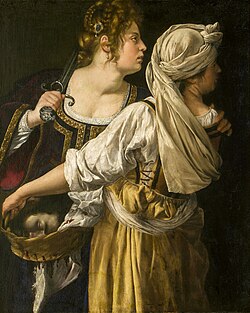
Laura's Blog

Historical #WCW: Artemisia Gentileschi
February 3, 2016
So she's not in any of my novels--nor in any of the periods I've written about!--but I just have to take a moment to talk about one of my personal heroines, Artemisia Gentileschi.

Self Portrait as the Allegory of Painting
Artemisia Gentileschi was born in Rome in 1593, the eldest child of the Tuscan painter Orazio Gentileschi. Artemisia was introduced to painting in her father's workshop, showing much more talent than her brothers. Unlike the rest of her family, her paintings were highly naturalistic.
In 1611, a co-worker of her father, Agostino Tassi, raped Artemisia. Orazio eventually pressed charges against Tassi, and Artemisia had to undergo a horrific and humiliating trial--she was even tortured to verify her testimony. The experience of this trial profoundly influence Artemisia to become not only one of the most famous Italian painters, but also a feminist heroine.
Judith slaying Holofernes
Artemisia married Pierantonio Stlattesi, an artist from Florence, with whom she has a daughter (who also became a painter.) In Florence, Artemisia flourished as a painter, even becoming the very first woman accepted into the Accademia delle Arti del Disegno. She moved several other times throughout her life following artistic opportunity--to Rome, Venice, Naples, and eventually England.
She enjoyed great success in her own lifetime, and became friends with brilliant and powerful people--Galileo, Michelangelo Buonarroti, and many members of the Medici family.
Judith and her Maidservant
Not only was Artemisia highly ahead of her time by being a female painter, the subjects of her paintings were dynamic and very contrary to the popular depictions of women at the time. She is credited with 57 works, and about 49 of these works feature women as protagonists, or equal to strength in men. Instead of being timid and weak, these women were courageous, rebellious, and powerful.
The brilliant and brave Artemisia turned the tragedy and horror of her young life into an expressive strength in painting heroines, and in doing so, has inspired generations of women--myself included!
While I hope to one day write about Artemisia, I have two other books I am contracted to write first! So if you are interested in learning more about her, I highly recommend reading The Passion of Artemisia by Susan Vreeland, one of my favorite authors.
I have included Artemisia on my list of kick-butt women from the Italian Renaissance. Check it out here:
/women-renaissance-da-vincis-tiger/

Other Blog Posts
Click Here to See All of Laura's Blog Posts


